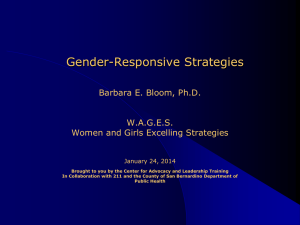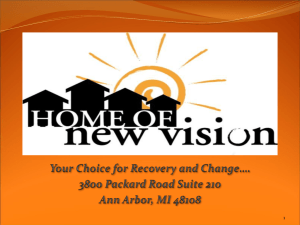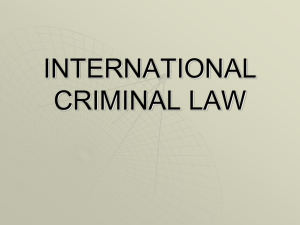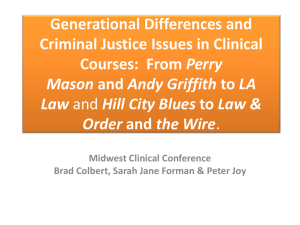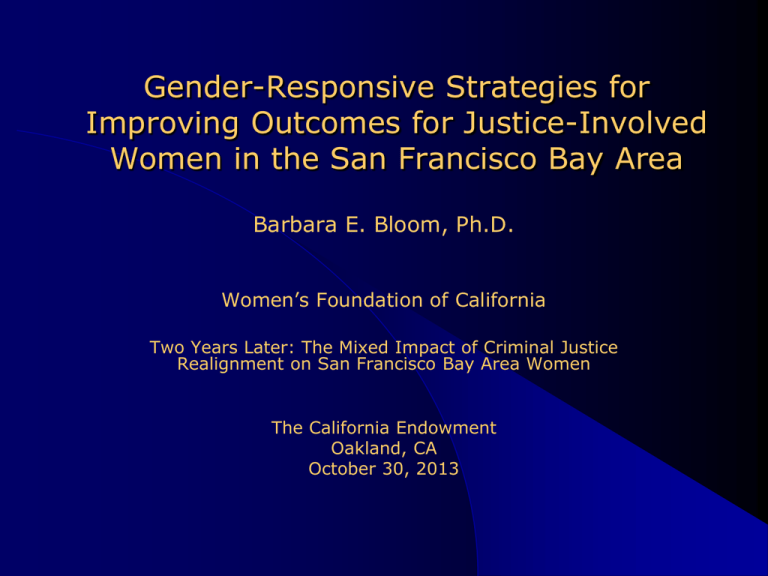
Gender-Responsive Strategies for
Improving Outcomes for Justice-Involved
Women in the San Francisco Bay Area
Barbara E. Bloom, Ph.D.
Women’s Foundation of California
Two Years Later: The Mixed Impact of Criminal Justice
Realignment on San Francisco Bay Area Women
The California Endowment
Oakland, CA
October 30, 2013
Overview
Three major themes:
Promotion of least restrictive alternatives to
custody by utilizing community services and
placements first;
Use of incarceration as the option of last
resort; and,
Emphasizing and investing in community
resources.
Women in the CJ System
Compared with men, women –
Have more severe histories of sexual/physical abuse
Have a higher prevalence of mental and physical health
problems, including trauma related to abuse
Have patterns of drug abuse that are more socially embedded
– revolving around their interpersonal relationships
Are typically primary caregivers for minor children
Have limited education and employment histories
Respond differently to treatment and supervision
Over 1 Million Women
are currently under
Criminal Justice Supervision
17% of total CJ Population
Over 80% under Community
Supervision
Imprisoned Women – U.S.
There were over 103,000 women incarcerated
in U.S. state and federal prisons in 2011 (6.7%
of the overall prison population).
Women of color made up about 43% of state
and federal prison populations.
African American women were imprisoned at
nearly 3 times the rate of white women and
Latinas were imprisoned at nearly twice the rate
of white women.
Source: BJS, Prisoners in 2011, December 2012
Imprisoned Women - CA
In 2011, there were 9,038 women in California
state prisons, down from 9,763 in 2010. The
number dropped to 5,919 on June 30, 2013.
Post-realignment, new prison admissions of
women declined by 60%.
Sources: CDCR, May 2013; CJCJ, March 2013
Women in U.S. Jails
In 2011, there were 93,300 women in local
jails (12.7% of the overall jail population), up
from 92,368 (12.3%) in 2010.
Approximately 60% of the jail population was
unconvicted and awaiting court action.
The greatest increase in the female jail
population was in California.
Source: BJS, Jail Inmates at Midyear 2012
Gender Differential in Offense
Patterns
Female crime rates usually much lower than
male rates.
Women’s crimes are predominantly:
•
•
•
•
Petty theft
Low-level drug use & sales
Minor fraud
Prostitution
The gender gap is greatest for serious crime
& least for less serious types of crime.
8
Gender Matters
Based upon the significant growth in women’s and girls’
involvement in the criminal justice system, it is important
for policy makers and practitioners to acknowledge the
appropriate role of gender in the criminal justice system.
Gender matters significantly in shaping patterns of
offending as well as the criminal justice system’s response
to criminal offending.
Gender is also important in examining the differential
effects of current policies and practices.
Current sentencing laws are based on male characteristics
and male crime and fail to take into account the reality of
women’s lives, characteristics, responsibilities, and roles in
crime.
“Doing Time”:
Women’s Experiences in
the Criminal Justice System
• Bail
• Sentencing policies
• Classification
• Programming
• Mother-Child contact
• Management strategies
• Transition to the community
What Does Gender
Responsive Mean?
Gender responsive means creating an
environment through site selection, staff
selection, program development, content
and material that reflects an
understanding of the realities of women’s
and girls’ lives and addresses their
challenges and strengths.
(Covington & Bloom, 2002)
Making the Case
for Appropriate Policy & Practice for
Criminal Justice Involved Women
Gender responsiveness is key to
improving outcomes for justice-involved
women by:
Acknowledging differences between men &
women
Targeting pathways to criminal justice
involvement
Developing policy & practice
Five Key Findings . . .
1. An effective system for females is
structured differently than for males
2.
Gender-responsive policy & practice
targets women’s pathways to criminality
by providing effective interventions that
address four central issues: substance
abuse, trauma, mental health, &
economic marginality
3.
Correctional sanctions & interventions
consider the lesser degree of harm created
by the typical offense patterns of women
4.
Gender-responsive policy & practice
considers women’s relationships (especially
family) & their roles in the community when
delivering both sanctions & interventions
5.
Community services are essential to a
gender-responsive CJ system
Mental
Illness
Substance
Abuse
Other
Health
Problems
HIV/
AIDS
Trauma
Homelessness
© S. Covington, 2012
Source: Vivian Brown, Ph.D.
Mental Health
Women in the criminal justice system have a
higher incidence of mental disorders than women
in general.
Women in the criminal justice system have
histories of abuse associated with psychological
trauma.
Approximately 75% with serious mental illness
also have co-occurring substance abuse
disorders.
Women with mental illness & co-occurring
disorders experience difficulties in prisons and
jails.
Substance Abuse, Mental
Health and Trauma
•
The interrelationship of substance abuse, mental health
& trauma is different in the lives of women
•
82% of women in jail had a lifetime substance use
disorder
•
53% had Post Traumatic Stress Disorder (PTSD) in their
lifetime
•
43% had a serious mental illness, such as depression,
bipolar disorder or schizophrenia
•
Source: Lynch, S., DeHart, D., Belknap, J. & Green, B. (2012). Pathways Project
Trauma History Among Criminal
Justice-involved Women
Women in the criminal justice system have
much higher rates of childhood and adult
trauma exposure than women in the
general population.
Trauma history is associated with alcohol
and drug dependence, high-risk behaviors,
sex work, and physical and mental health
disorders among women in criminal justice
settings.
© S. Covington, Ph.D., 2012
Children
•
Approximately 70%
of women under
correctional
supervision have at
least 1 child under 18
•
Two-thirds of
incarcerated women
have children under
18
•
An estimated 1.3
million minor children
have a mother under
correctional
supervision
•
More than a quarter of
a million children have
mothers in jail or
prison
Reentry Challenges
Reunification with Children
Employment
Housing
Substance abuse Treatment
Medical and Mental Health Services
Childcare
Support Systems
Legal Barriers Facing Women
Returning to Their Communities
Personal Responsibility & Work
Opportunity Act of 1996
Temporary Assistance for Needy
Families (TANF)
Higher Education Act of 1998
Public Housing - Section 8
Adoption and Safe Families Act of 1997
Discrimination (employment, voting,
etc.)
Guiding Principles for
Gender-Responsive Services
Gender
Environment
Relationships
Services & Supervision
Economic & Social Status
Community
The Foundation for
Women’s Services
Safety
• Community
• Institutional
Rehabilitation
• Programming
• Treatment
• Services
Services and Programs for Women
Should Acknowledge Gender Issues
• Substance abuse
• Physical, sexual, and psychological abuse
• Health and mental health
• Education & vocational training
• Housing
• Life skills
Research-Based Best Practices
• Gender-responsive theoretical foundation;
• Assessment and intensive case
management;
• Services that address women’s pathways;
• Transitional planning and community
reintegration;
• Coordinated case management systems
that are women-centered, including justiceinvolved women and peer mentors in the
planning process;
• Staff trained in gender-responsive practice
and trauma-informed treatment;
• Interventions are trauma-informed; and
• Material needs such as housing,
transportation and childcare are addressed.
Research Supported Practices
• Acknowledge how relationships affect
women’s lives
• Develop coordinated case management that
is strength-based, trauma-informed,
relational, and culturally competent
• Build partnerships with a range of
community organizations (public and
private) to establish gender and culturally
responsive multidimensional, wraparound
services
City and County of San Francisco
Women’s Community Justice Reform Blueprint
Integrate criminal justice and community services and
programs through a collaborative leadership structure.
Develop sentencing and pretrial alternatives by expanding
noncustodial and community alternatives, including motherchild alternative sentencing programs.
Create an intensive and coordinated case management system
that follows women through every phase of the criminal justice
process.
Expand and enhance programming that creates a continuum
across systems, combining criminal justice and community
services.
Design an integrated data collection, evaluation and oversight
process to monitor, inform and improve systems.
Going Forward: What is Our Work?
Reducing women’s incarceration
Expanding pre-trial and sentencing
options
Developing a collaborative case
management system
Enhancing women’s programs and
services
Investing in the community
“…women whose lives represent all
women’s issues-magnified.”
Resources
Center for Gender and Justice
centerforgenderandjustice.org
National Institute of Corrections
nicic.gov
Barbara Bloom
bloom@sonoma.edu



